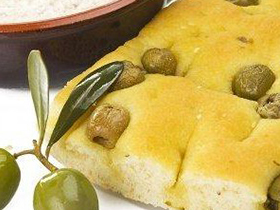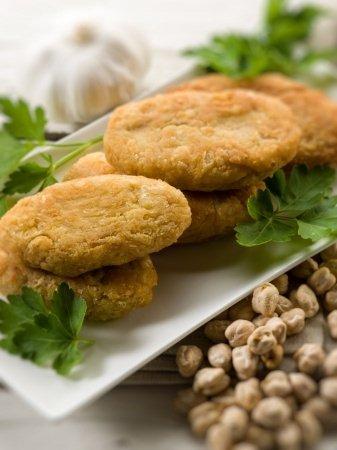
Introduction to Bread & Focacce
Many baked unsweetened specialties which are neither a bread nor an entrée are cooked in Sicily and consumed as a snack, appetizer or for a hearty meal. The word focaccia derives from Latin focacius meaning cooked under the ashes. In Sicily, the focacce are baked for special occasions and they are always part of the Christmas Eve and New Year’s Eve festivities.
Some food historians claim that the sfincione and all the other stuffed breads called impanata, or scacciata, crushed, or coddirune, stuck together, were introduced in Sicily by the Moors. The sfincione actually goes back centuries long before the Greeks’ or Romans’ controlled Sicily, the simple flatbread was the major component of the everyday diet.
When used as the staple food for soldiers and sailors, it had to be kept for many days; therefore, oil and olives were added to preserve it and make it more palatable and acceptable for a longer period of time. Over time, the additions of onions, cheese, and finally tomato, produced what is today’s sfincione.
The Iraqi simbusak that the Saracens were eating in the Iberian Peninsula or in Sicily, was a very different product consisting of fried chickpea dough on the outside, stuffed with meat or cheese; plain chickpeas fritters had been for a long time, part of the traditional Sicilian cuisine.

In the Iberian Peninsula the empanada, like the sfincione, was there before the Moors, and the similarity between an empanada and a simbusak is enormous, due to the diversity of the basic ingredients, the cooking and the preparation procedures. Perhaps a distant cousin of the simbusak is the pane e panelle, bread and chickpea fritters, where the casing is the bread and the fried chickpea fritters became the stuffing.
The empanada, under other names, was prepared and consumed in many European countries. The Moors mastered the making and introduced the empanada in the Philippines and other Moslem countries while the Spanish and the Portuguese immigrants brought it to the Americas.
Another theory is that the Syrian Sephardic Jews, who, after the Diaspora were in great numbers in Sicily, introduced to the island the sambusak, a baked flaky sesame seed pastry, in the shape of a half-moon, filled with meat or cheese, and traditionally eaten on the Sabbaths and Hanukah.
The Jewish sambusak influenced the production of some desserts and snacks made nowadays, consisting of a pastry similar to a turnover, stuffed with various creams, marmalades, cheeses, meat or fish.
In every city, in every family, a specialty that goes under this category is baked using different methods and ingredients.

In Palermo, the classic sfincione is prepared in three manners: Palermo style, Bagheria style and in the style of the convent of San Vito.
The fertile province of Catania is famous for the schiacciate stuffed with the locally grown purple cauliflower, called u bastardu, salted anchovies, and cheeses and for the crispeddi stuffed with anchovies and aromatized with dill or crushed fennel seeds.
In Syracuse the impanata is made with bread dough, slightly bitter broccoli rape, sweet sausages and with tasty and racy caciocavallo cheese to produce a unique and unequaled focaccia with contrasting and interesting tastes.
The impanata prepared in Messina is made with short dough without sugar and stuffed with swordfish, onions, tomatoes, celery, capers, raisins, pine nuts, olives and cheese. In the Nebrodi Mountains, meat, cheese and vegetables became the main ingredients.

U pastizzu or ‘mpanata is made in Ragusa, with bread dough stuffed either with cauliflower, spinach, sausage or lamb in combination with caciocavallo cheese and tomato. The scacce are in the shape of large turnovers and stuffed with tomato, eggplant, cauliflower or other vegetables mixed with fresh local cheese.
Fuata Nissena is a small thin focaccia made in Caltanissetta ; it is covered with tomatoes, anchovies, and pecorino. The ‘nbruliate are made with two sheets of phyllo dough; they stuffed with pork and primosale, a fresh cheese, rolled up and baked as a loaf.
The guastedda ‘nfighiulata is a round focaccia made in Enna; it is stuffed with cheese and sambuco flowers produced by the elderberry shrubs or trees.
In Agrigento and Porto Empedocle, the baked bread dough stuffed with olives and scallions are called ‘nmiscati, whereas the mignulati are stuffed with sausage meat and cheese.
Cuddiruna is a rectangular focaccia stuffed with onions, tomatoes, potatoes, anchovies, herbs and cheese. The cuddiruna in bianco, a “white” version is made using cauliflower instead of tomato.
An oval focaccia layered with tomato, cheese, anchovies, garlic, oil and abundant oregano is baked in Trapani. The oregano is called riano and this focaccia is called rianata.
Go to the Baked Delicacies menu for more information and recipes.
